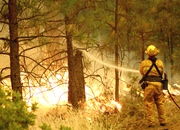When to Say No -- How to Refuse Risk Properly
Accepting risk is part of the job of being a firefighter. But no employer has the right to force you to take an unacceptable risk, particularly if there are safe alternatives for completing the assignment.
The guidelines -- published by the National Wildfire Coordinating Group -- spell out the proper way to exercise your right to refuse risk that you believe extends beyond the boundaries of the job.
NWCG Guidelines -- How to Refuse Risk Properly
 Every individual has the right and obligation to report safety problems and contribute ideas regarding their safety. Supervisors are expected to give these concerns and ideas serious consideration.
Every individual has the right and obligation to report safety problems and contribute ideas regarding their safety. Supervisors are expected to give these concerns and ideas serious consideration.
When an individual feels an assignment is unsafe they also have the obligation to identify, to the degree possible, safe alternatives for completing that assignment. Turning down an assignment is one possible outcome of managing risk.
A “turn down” is a situation where an individual has determined they cannot undertake an assignment as given and they are unable to negotiate an alternative solution. The turn down of an assignment must be based on an assessment of risks and the ability of the individual or organization to control those risks. Individuals may turn down an assignment as unsafe when:
- There is a violation of safe work practices.
- Environmental conditions make the work unsafe.
- They lack the necessary qualifications or experience.
- Defective equipment is being used.
If a turn down situation presents itself, the process for resolving it in the field is as follows:
- Individual will directly inform their supervisor that they are turning down the assignment as given. The most appropriate means to document the turn down is using the criteria (The Firefighting Orders, the Watch Out Situations, etc.) outlined in the Risk Management Process.
- Supervisor will notify the Safety Officer immediately upon being informed of the turn down. If there is no Safety Officer, notification shall go to the appropriate Section Chief or to the Incident Commander. This provides accountability for decisions and initiates communication of safety concerns within the incident organization.
- If the supervisor asks another resource to perform the assignment, they are responsible to inform the new resource that the assignment has been turned down and the reasons that it was turned down.
- If an unresolved safety hazard exists or an unsafe act was committed, the individual should also document the turn down by submitting a SAFENET (ground hazard) or SAFECOM (aviation hazard) form in a timely manner.
These actions do not stop an operation from being carried out. This protocol is integral to the effective management of risk as it provides timely identification of hazards to the chain of command, raises risk awareness for both leaders and subordinates, and promotes accountability.